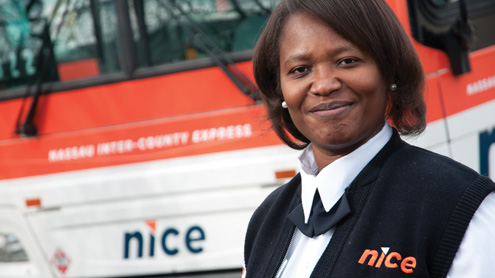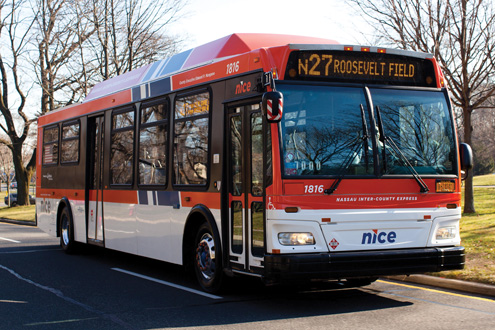
Private sector partnership serves as a model for cost savings
By Ken Westbrook
Veolia President and COO
Transit Division

On New Year’s Day 2012, Veolia Transportation made transit history when it launched service for Nassau Inter-County Express (NICE), Long Island, NY, the largest private transit contract in North America. Already known as America’s first suburb, Nassau County is gaining further recognition for its innovation in management of public transportation, which serves as a successful public-private model for other transit systems facing rising costs and dwindling revenues.
Breaking from a 30-year history when the Metropolitan Transit Authority (MTA) operated the system, NICE now operates under a public-private operating partnership (PPOP) between Nassau County and Veolia Transportation, Lombard, IL, North America’s largest private sector operator of public transportation. This hybrid approach allows Nassau to maintain control and oversight of its bus and paratransit system while it benefits from the experience, innovation and resources of a private operator.
“NICE now operates at approximately $43 million less than the $156 million the Metropolitan Transportation Authority projected for 2012,” says Nassau County Executive Edward P. Mangano. “Yet it still runs every route the MTA did.”
Under the PPOP, Nassau County continues to own all hard assets, its 400 buses and paratransit vehicles, garages, transit centers, and equipment. It also retains ultimate policy control on budgets, fare structure and quality and quantity of service. Veolia is responsible for almost everything else — operations, maintenance, service design, scheduling, grants management, marketing, finance, passenger information and care, and overall management.
Reduce costs, maintain service quality
Nearly 100,000 daily riders in Nassau rely on bus transportation. Like many communities, Nassau has faced unprecedented fiscal challenges to maintain services with rising costs and inadequate revenues. In 2011, MTA chose not to renew its contract with Nassau County due to shortfalls in funding the bus system.
Instead of drastically cutting service, placing an additional burden on taxpayers, raising fares or assuming the huge task of operating the system itself, Nassau decided it would partner with a private, professional transportation management company and work jointly to modernize its underperforming system to make it affordable and sustainable.
Following a six-month competitive bid process managed by the county, the internal review committee selected Veolia from three bidders. Months of contract negotiations between the county and Veolia followed and in December 2011, after a seven-hour public hearing, the 19-member county legislature unanimously approved a five-year contract with a five-year renewal option with Veolia to begin on January 1, 2012.
Transition to NICE
Converting a large public bus system with 300 fixed route and 97 paratransit vehicles to a new management entity in a compressed timeframe was a massive challenge. The transition process to NICE began earnestly in early summer of 2011.
First steps included appointing CEO Mike Setzer and COO Roger Chapin, who have over 60 years of combined urban bus transit experience, to lead the transition effort and oversee the system. More than 130 Veolia staff members from around the country who are experts in multiple disciplines traveled to Nassau to incorporate their operational best practices and best-in-class technology in the Nassau plan.
In only two months, Veolia interviewed, hired and trained about 1,000 employees, most from the MTA, who had applied and were qualified for available positions. The company assigned a position and issued a uniform to every union worker who applied with NICE. Between Thanksgiving and Christmas, Veolia designed and distributed 12,000 pieces of clothing.
Preparing the facilities and the fleet was another challenge. The State DOT had to fully inspect the entire fleet and MTA needed to correct all reported failures before Veolia could take possession, all while maintaining normal bus service. The plan included the creation of a new name and complete rebranding package using Nassau County’s blue and orange colors. NICE published new timetables, maps and schedules for 48 routes created from scratch, along with a new website, new transit center signs, new uniforms and new building signage.
In early January, after three years working without a contract, members of the Transport Workers’ Union voted 450 to 58 to ratify a five-year agreement with Veolia. The contract provided raises for employees in exchange for some important productivity improvements.
Mark Joseph, CEO of Veolia Transportation, praised his company for accomplishing this transition in record time while simultaneously increasing quality and reducing costs for Nassau County.
Successful rollout and start-up
It all came together on January 1, 2012 and NICE began to roll. During its first year of operation many improvements focused on meeting the county’s goals for the PPOP.
The first is cost savings. Through a series of measures, including bulk purchasing, centralized administration, improved maintenance and operational practices, and more, Veolia has been able to reduce system costs by tens of millions of dollars. At the same time, fares for 2012 were not increased. Fares now cover 48 percent of operating costs.
The system is also performing better with fewer missed runs and late buses, in no small part to Veolia’s strong emphasis on managing service quality. Customer satisfaction, which was very low in 2011, has made steady progress through the first half of 2012. Today, Veolia has its focus squarely on improving the rider experience.

Veolia has also successfully made NICE a more efficient system, maximizing the funds available to run the operation. A successful long-overdue service redesign in April allowed NICE to make adjustments to improve the most heavily routes by riders and to establish new service where demand called for it, including new express service to and from New York City.
These carefully considered adjustments provide the greatest benefit to the largest number of riders, while impacting the fewest passengers possible. There were no route cancellations. The vast majority of cost-saving changes were frequency adjustments, particularly in off-peak time. Though its contract did not require it to hold public hearings, Veolia hosted six hours of community meetings to personally discuss the proposed changes and gather rider input.
While there have been many improvements, as well as challenges, Veolia and the county have additional improvements planned for the remainder of 2012, including the purchase of 45 new fixed-route buses, new on-board electronics, and communications technology to improve system performance.
Contract supports all interests
The contract with Veolia provides numerous safeguards and advantages for the county, especially in the financial area. For example, Nassau now has a legally binding contract that defines performance expectations and guarantees a cost for operating the service that is enforceable by law.
In fact, Veolia’s contract with the county requires that NICE operate with a balanced budget, which must be established annually by April 1. Receiving pay in part for platform hours actually incentivizes Veolia to increase and improve service.
“NICE bus has both the latitude and the responsibility to manage costs and please customers,” says Setzer. “We are incentivized in exactly the right ways to efficiently manage the county’s transportation system, and provide the highest quality of service the county can afford. We are only eight months into our contract and we will be delivering many more improvements as time goes on.” BR
Ken Westbrook serves as president and COO for Veolia Transportation, Transit Division, Lombard, IL, and is a member of the BUSRide Editorial Advisory Board.
